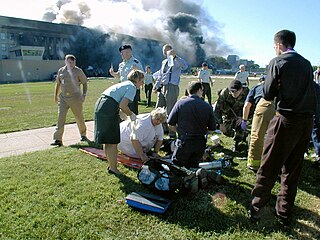
In medicine, triage is a process by which care providers such as medical professionals and those with first aid knowledge determine the order of priority for providing treatment to injured individuals and/or inform the rationing of limited supplies so that they go to those who can most benefit from it. Triage is usually relied upon when there are more injured individuals than available care providers, or when there are more injured individuals than supplies to treat them.
Time management is the process of planning and exercising conscious control of time spent on specific activities—especially to increase effectiveness, efficiency and productivity.
Health has a variety of definitions, which have been used for different purposes over time. In general, it refers to physical and emotional well-being, especially that associated with normal functioning of the human body, absent of disease, pain, or injury.

Health care, or healthcare, is the improvement of health via the prevention, diagnosis, treatment, amelioration or cure of disease, illness, injury, and other physical and mental impairments in people. Health care is delivered by health professionals and allied health fields. Medicine, dentistry, pharmacy, midwifery, nursing, optometry, audiology, psychology, occupational therapy, physical therapy, athletic training, and other health professions all constitute health care. The term includes work done in providing primary care, secondary care, tertiary care, and public health.
Clinical governance is a systematic approach to maintaining and improving the quality of patient care within the National Health Service (NHS) and private sector health care. Clinical governance became important in health care after the Bristol heart scandal in 1995, during which an anaesthetist, Dr Stephen Bolsin, exposed the high mortality rate for paediatric cardiac surgery at the Bristol Royal Infirmary. It was originally elaborated within the United Kingdom National Health Service (NHS), and its most widely cited formal definition describes it as:
A framework through which NHS organisations are accountable for continually improving the quality of their services and safeguarding high standards of care by creating an environment in which excellence in clinical care will flourish.
Allied health professions (AHPs) are a category of health professionals that provide a range of diagnostic, preventive, therapeutic, and rehabilitative services in connection with health care. While there is no international standard for defining the diversity of allied health professions, they are typically considered those which are distinct from the fields of medicine, nursing and dentistry.
Health promotion is, as stated in the 1986 World Health Organization (WHO) Ottawa Charter for Health Promotion, the "process of enabling people to increase control over, and to improve their health."
A patient safety organization (PSO) is a group, institution, or association that improves medical care by reducing medical errors. Common functions of patient safety organizations are data collection, analysis, reporting, education, funding, and advocacy. A PSO differs from a Federally designed Patient Safety Organization (PSO), which provides health care providers in the U.S. privilege and confidentiality protections for efforts to improve patient safety and the quality of patient care delivery

Health literacy is the ability to obtain, read, understand, and use healthcare information in order to make appropriate health decisions and follow instructions for treatment. There are multiple definitions of health literacy, in part because health literacy involves both the context in which health literacy demands are made and the skills that people bring to that situation.
Health information management (HIM) is information management applied to health and health care. It is the practice of analyzing and protecting digital and traditional medical information vital to providing quality patient care. With the widespread computerization of health records, traditional (paper-based) records are being replaced with electronic health records (EHRs). The tools of health informatics and health information technology are continually improving to bring greater efficiency to information management in the health care sector.

The Swedish health care system is mainly government-funded, universal for all citizens and decentralized, although private health care also exists. The health care system in Sweden is financed primarily through taxes levied by county councils and municipalities. A total of 21 councils are in charge with primary and hospital care within the country.

Disaster medicine is the area of medical specialization serving the dual areas of providing health care to disaster survivors and providing medically related disaster preparation, disaster planning, disaster response and disaster recovery leadership throughout the disaster life cycle. Disaster medicine specialists provide insight, guidance and expertise on the principles and practice of medicine both in the disaster impact area and healthcare evacuation receiving facilities to emergency management professionals, hospitals, healthcare facilities, communities and governments. The disaster medicine specialist is the liaison between and partner to the medical contingency planner, the emergency management professional, the incident command system, government and policy makers.
Health information technology (HIT) is health technology, particularly information technology, applied to health and health care. It supports health information management across computerized systems and the secure exchange of health information between consumers, providers, payers, and quality monitors. Based on a 2008 report on a small series of studies conducted at four sites that provide ambulatory care – three U.S. medical centers and one in the Netherlands, the use of electronic health records (EHRs) was viewed as the most promising tool for improving the overall quality, safety and efficiency of the health delivery system.

The James Lind Alliance is a UK-based non-profit making initiative, established in 2004. It was established to bring patients, carers and clinicians together, in Priority Setting Partnerships, to identify and prioritise unanswered questions or evidence uncertainties that they agree are the most important. The intention is to ensure that those who fund health research are aware of what matters to patients, carers and clinicians who need to use the research in their everyday lives.
Patient participation is a trend that arose in answer to medical paternalism. Informed consent is a process where patients make decisions informed by the advice of medical professionals.
Health care quality is a level of value provided by any health care resource, as determined by some measurement. As with quality in other fields, it is an assessment of whether something is good enough and whether it is suitable for its purpose. The goal of health care is to provide medical resources of high quality to all who need them; that is, to ensure good quality of life, cure illnesses when possible, to extend life expectancy, and so on. Researchers use a variety of quality measures to attempt to determine health care quality, including counts of a therapy's reduction or lessening of diseases identified by medical diagnosis, a decrease in the number of risk factors which people have following preventive care, or a survey of health indicators in a population who are accessing certain kinds of care.
Evidence Aid is an international platform that was formed out of the need to deliver time sensitive access to systematic reviews for use in the event of disasters and other humanitarian emergencies. The method of using systematic reviews is to provide evidence for use by policy makers, clinicians, regulators, and even the general public who benefit when these materials are easy to understand and are accessible. The vision of Evidence Aid is to create and satisfy an increasing demand for evidence to improve the impact of humanitarian aid by stimulating the use of an evidence-based approach. Evidence Aid was founded in 2004. It is currently a project that is housed by the Cochrane Collaboration and Queen's University Belfast. Evidence Aid was established by several members of the international Cochrane Collaboration following the 2004 Indian Ocean earthquake and tsunami. Evidence Aid was formed to provide systematic reviews on the effects of interventions and actions of relevance prior to, in the course of and during the aftermath of disasters or other humanitarian emergencies, in order to improve health-related outcomes; their aim is to work with those who need and use this evidence, as well as working with researchers and publishers to facilitate freely accessible materials to meet the information needs for those facing humanitarian emergencies and disasters. Evidence Aid works in collaboration with other organizations including Public Health England; Red Cross Flanders, International Rescue Committee; Centers for Disease Control; Centre for Evidence-Based Medicine; and the University of Oxford.
In global health, priority-setting is a term used for the process and strategy of deciding which health interventions to carry out. Priority-setting can be conducted at the disease level, the overall strategy level, research level, or other levels.

Healthcare in Azerbaijan is provided by public and private healthcare institutions and regulated through the Ministry of Healthcare.
Learning health systems (LHS) are health and healthcare systems in which knowledge generation processes are embedded in daily practice to improve individual and population health. At its most fundamental level, a learning health system applies a conceptual approach wherein science, informatics, incentives, and culture are aligned to support continuous improvement, innovation, and equity, and seamlessly embed knowledge and best practices into care delivery








